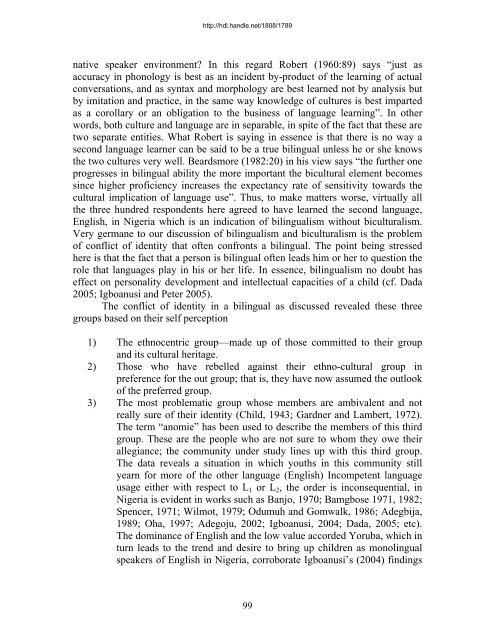LANGUAGE CONTACT AND LANGUAGE ... - KU ScholarWorks
LANGUAGE CONTACT AND LANGUAGE ... - KU ScholarWorks
LANGUAGE CONTACT AND LANGUAGE ... - KU ScholarWorks
Create successful ePaper yourself
Turn your PDF publications into a flip-book with our unique Google optimized e-Paper software.
http://hdl.handle.net/1808/1789<br />
native speaker environment? In this regard Robert (1960:89) says “just as<br />
accuracy in phonology is best as an incident by-product of the learning of actual<br />
conversations, and as syntax and morphology are best learned not by analysis but<br />
by imitation and practice, in the same way knowledge of cultures is best imparted<br />
as a corollary or an obligation to the business of language learning”. In other<br />
words, both culture and language are in separable, in spite of the fact that these are<br />
two separate entities. What Robert is saying in essence is that there is no way a<br />
second language learner can be said to be a true bilingual unless he or she knows<br />
the two cultures very well. Beardsmore (1982:20) in his view says “the further one<br />
progresses in bilingual ability the more important the bicultural element becomes<br />
since higher proficiency increases the expectancy rate of sensitivity towards the<br />
cultural implication of language use”. Thus, to make matters worse, virtually all<br />
the three hundred respondents here agreed to have learned the second language,<br />
English, in Nigeria which is an indication of bilingualism without biculturalism.<br />
Very germane to our discussion of bilingualism and biculturalism is the problem<br />
of conflict of identity that often confronts a bilingual. The point being stressed<br />
here is that the fact that a person is bilingual often leads him or her to question the<br />
role that languages play in his or her life. In essence, bilingualism no doubt has<br />
effect on personality development and intellectual capacities of a child (cf. Dada<br />
2005; Igboanusi and Peter 2005).<br />
The conflict of identity in a bilingual as discussed revealed these three<br />
groups based on their self perception<br />
1) The ethnocentric group—made up of those committed to their group<br />
and its cultural heritage.<br />
2) Those who have rebelled against their ethno-cultural group in<br />
preference for the out group; that is, they have now assumed the outlook<br />
of the preferred group.<br />
3) The most problematic group whose members are ambivalent and not<br />
really sure of their identity (Child, 1943; Gardner and Lambert, 1972).<br />
The term “anomie” has been used to describe the members of this third<br />
group. These are the people who are not sure to whom they owe their<br />
allegiance; the community under study lines up with this third group.<br />
The data reveals a situation in which youths in this community still<br />
yearn for more of the other language (English) Incompetent language<br />
usage either with respect to L 1 or L 2 , the order is inconsequential, in<br />
Nigeria is evident in works such as Banjo, 1970; Bamgbose 1971, 1982;<br />
Spencer, 1971; Wilmot, 1979; Odumuh and Gomwalk, 1986; Adegbija,<br />
1989; Oha, 1997; Adegoju, 2002; Igboanusi, 2004; Dada, 2005; etc).<br />
The dominance of English and the low value accorded Yoruba, which in<br />
turn leads to the trend and desire to bring up children as monolingual<br />
speakers of English in Nigeria, corroborate Igboanusi’s (2004) findings<br />
99
















